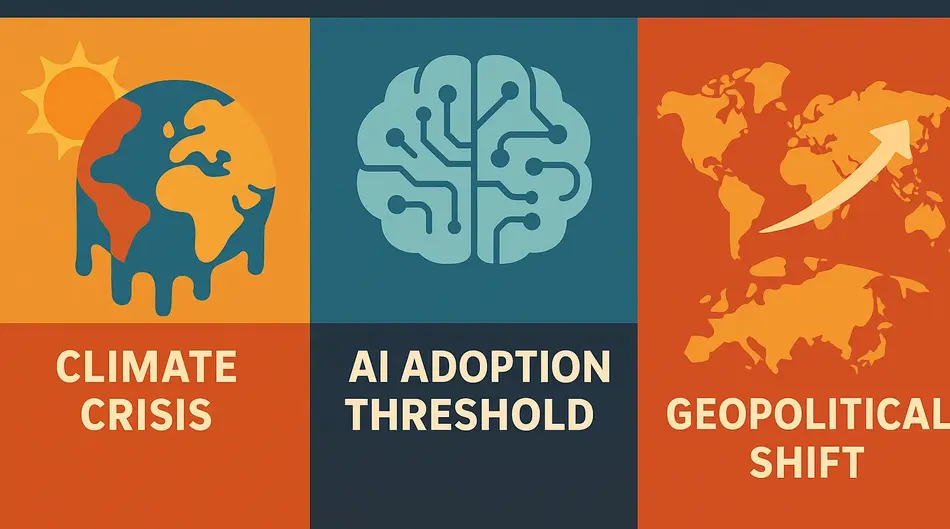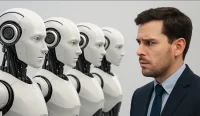The Dawn of a New Technological Era
We are living in an extraordinary moment in history. The year 2025 marks a pivotal juncture where three world-historic, game-changing technologies are beginning to scale simultaneously, creating unprecedented transformation across society, business, and governance. These technological tipping points mirror previous revolutionary periods in American history, suggesting we’re entering another 25-year cycle of explosive innovation and progress.
As Pete Leyden, a technology futurist who has tracked technological evolution since the early days of the internet at Wired Magazine explains, “We are in the middle of three world-historic tipping points that are world-historic changes happening around us today.” Understanding these tipping points is crucial for navigating the rapidly changing landscape of our world.
What Are Technological Tipping Points?
Technological tipping points occur when innovations transition from slow, incremental development to explosive, widespread adoption. They represent the moment when a technology crosses from being clunky and experimental to becoming indispensable.
“When do you go from the slow, slow build of a thing that’s kind of clunky and not really working, to, you all of a sudden get an iPhone that goes, holy shit, this is the most amazing thing in the world, and then everybody needs them?” Leyden asks.
These tipping points don’t just change how we use technology—they fundamentally reshape economies, societies, and governance structures. We’re currently witnessing three such transformative shifts occurring simultaneously.
The Three World-Historic Tipping Points of 2025
1. Artificial Intelligence: The Age of AI Begins
The most visible and perhaps most profound tipping point is the emergence of artificial intelligence as a transformative technology. The arrival of generative AI with ChatGPT 3.5 in November 2022 marked what many consider the starting gun of the AI age.
“I think people will look back on that as a world-historic moment,” notes Leyden. “When you talk about a different age that humans enter, like the Bronze Age or the Iron Age, you’re talking about essentially a fundamental, game-changing technology, a breakthrough, a step-change in our abilities, that once you cross that threshold, you don’t go back.”
AI represents an unprecedented amplification of human mental capabilities, similar to how mechanical engines amplified our physical powers during the Industrial Revolution. We’re only beginning to witness the explosion of capabilities that AI will enable across every sector of society and business and see the latest at MIT Technology Review.
2. Clean Energy: The Technology-Driven Energy Revolution
The second tipping point involves our transition to clean energy sources—particularly solar power, battery technology, and electric vehicles. Unlike previous energy sources that were commodities (coal, oil), clean energy is fundamentally technology-based, which means it follows technology cost curves rather than scarcity-based pricing.
“This is the first time we have an energy source that is a technology, a hundred percent a technology, not a commodity,” Leyden explains. “Once it’s a technology, you can consistently drive down the cost.”
Solar panels follow a manufacturing rule of thumb: doubling production typically results in a 20% cost reduction. The same principle applies to battery technology for electric vehicles. As these technologies scale, they become increasingly affordable, eventually making clean energy the obvious economic choice regardless of environmental concerns. See the World Economic Forum’s take.
3. Bioengineering: Editing Life Itself
The third tipping point involves our newfound ability to understand and edit the genetic code of living organisms. Around the same time as our breakthroughs in generative AI, we developed CRISPR technology, allowing us to cheaply and easily edit the genome of any living thing.
The implications are staggering—from lab-grown meat that’s molecularly identical to animal products but produced without environmental impact, to medical treatments that target the genetic roots of disease. The cost of sequencing the human genome has plummeted from $3 billion in 2003 to around $100 today, with further reductions expected.
“We can now essentially design these things for outcomes that we want to happen cheaply and easily,” says Leyden, highlighting how bioengineering is moving from theoretical to practical applications at unprecedented speed. Read more at Nature.
Historical Context: America’s 80-Year Reinvention Cycles
What makes our current moment even more significant is how it fits into broader historical patterns. According to Leyden, America experiences major reinvention cycles approximately every 80 years, with each cycle featuring a 25-year burst of transformative innovation.
The Post-World War II Transformation (1945-1970)
Following World War II, America experienced extreme polarization and conflict before embarking on a 25-year period of unprecedented economic growth and social transformation. This era saw:
- 90% tax rates on the wealthy to fund public investments
- Massive infrastructure projects like the interstate highway system
- Expansion of higher education through the GI Bill
- Creation of suburbs and the modern middle class
- Development of social programs like Medicare and the Great Society
These changes fundamentally reinvented American society and the global economy, creating what many consider the high point of global capitalism.
The Post-Civil War Transformation (1865-1890)
Going back another 80 years, the end of the Civil War marked another transformative period in American history. Following the conflict, America experienced:
- The Homestead Act, providing 150 acres of free land to settlers
- Creation of land grant universities to advance education and agricultural science
- Construction of 175,000 miles of railroads, connecting the continent
- Industrialization and the rise of modern corporations
- Waves of immigration and westward expansion
The Founding Transformation (1787-1810)
And 80 years before that, America’s founding period represented another fundamental reinvention—the creation of a democratic republic based on Enlightenment principles, moving away from feudal and monarchical systems.
Building a 21st Century Civilization
What makes our current moment so significant is that we’re not just experiencing technological change—we may be witnessing the early stages of building an entirely new civilization for the 21st century. This transformation extends beyond technology to include:
From Financial Capitalism to Sustainable Capitalism
Our economic system has increasingly benefited the top 10% while failing to work for the remaining 80%. The technologies emerging today could enable a shift from financial capitalism to sustainable capitalism—an economic system that values environmental sustainability, broader prosperity, and long-term thinking.
From Representative Democracy to Digital Democracy
Our democratic systems, designed for an 18th-century world, are struggling to address 21st-century challenges. New technologies could enable more direct, responsive, and participatory forms of governance.
From Nation States to Global Governance
As challenges like climate change, pandemics, and technological risks transcend national borders, we may see evolution from a world of nation-states to systems of global governance that can coordinate responses among 10 billion people.
What This Means for Your Future
These world-historic tipping points will reshape careers, industries, and daily life in profound ways. To navigate this transformative period successfully:
- Develop adaptability and continuous learning habits – The pace of change will require ongoing skill development and flexibility.
- Look for opportunities at the intersection of these technologies – The most promising careers and businesses will combine AI, clean energy, and bioengineering in novel ways.
- Consider the ethical implications – As we gain unprecedented power to reshape our world, ethical considerations become increasingly important.
- Prepare for systemic change – Beyond individual technologies, be ready for fundamental shifts in economic, political, and social systems.
- Recognize the historical significance – Understanding that we’re in a once-in-80-years transformation can help contextualize the disruption and opportunity around us.
Conclusion: Embracing the Challenge of Our Time
We stand at a unique moment in history—one that parallels previous transformative periods but with potentially even greater significance. The convergence of AI, clean energy, and bioengineering represents not just technological change but the foundation for an entirely new civilization.
“That’s the level of change I think we’re actually heading into. That’s the level of change I think your kids are going to be wrestling with. And that’s the level of change I think America is going through now,” concludes Leyden.
By understanding these world-historic tipping points and their historical context, we can better prepare for the challenges and opportunities ahead. The quicker we wrap our heads around the scale of invention required, the better positioned we’ll be to shape a future that works for everyone.
Ready to Thrive in the AI, Energy, or Biotech Boom?
Explore emerging roles on WhatJobs – Discover your next career move in industries shaped by tomorrow’s tech.
Post a Job Now →FAQ: Understanding Technological Tipping Points
What are the three world-historic tipping points reshaping our future in 2025?
The three world-historic tipping points reshaping our future in 2025 are artificial intelligence (particularly generative AI), clean energy technologies (solar, batteries, and electric vehicles), and bioengineering (including CRISPR gene editing). These technologies are simultaneously reaching inflection points where they transition from experimental to transformative, creating unprecedented change across society.
How do technological tipping points relate to historical patterns in American development?
Technological tipping points align with America’s approximately 80-year cycles of reinvention. Similar transformative periods occurred after World War II (1945-1970), after the Civil War (1865-1890), and during America’s founding (1787-1810). Each period featured intense social polarization followed by roughly 25 years of explosive innovation and progress that fundamentally reinvented society, suggesting our current transformation follows a historical pattern.
How will these world-historic tipping points affect jobs and the economy?
These world-historic tipping points will dramatically transform the job market and economy by automating many existing roles while creating entirely new industries and opportunities. The transition will likely be disruptive in the short term but potentially create greater prosperity long-term. Success will require adaptability, continuous learning, and focusing on uniquely human skills that complement rather than compete with new technologies.
What can individuals do to prepare for these world-historic changes?
To prepare for these world-historic changes, individuals should: 1) Develop adaptability and continuous learning habits; 2) Look for opportunities at the intersection of AI, clean energy, and bioengineering; 3) Consider the ethical implications of these technologies; 4) Prepare for fundamental shifts in economic and social systems; and 5) Stay informed about technological developments. Those who understand the scale and significance of these changes will be best positioned to thrive in the transformed landscape.




